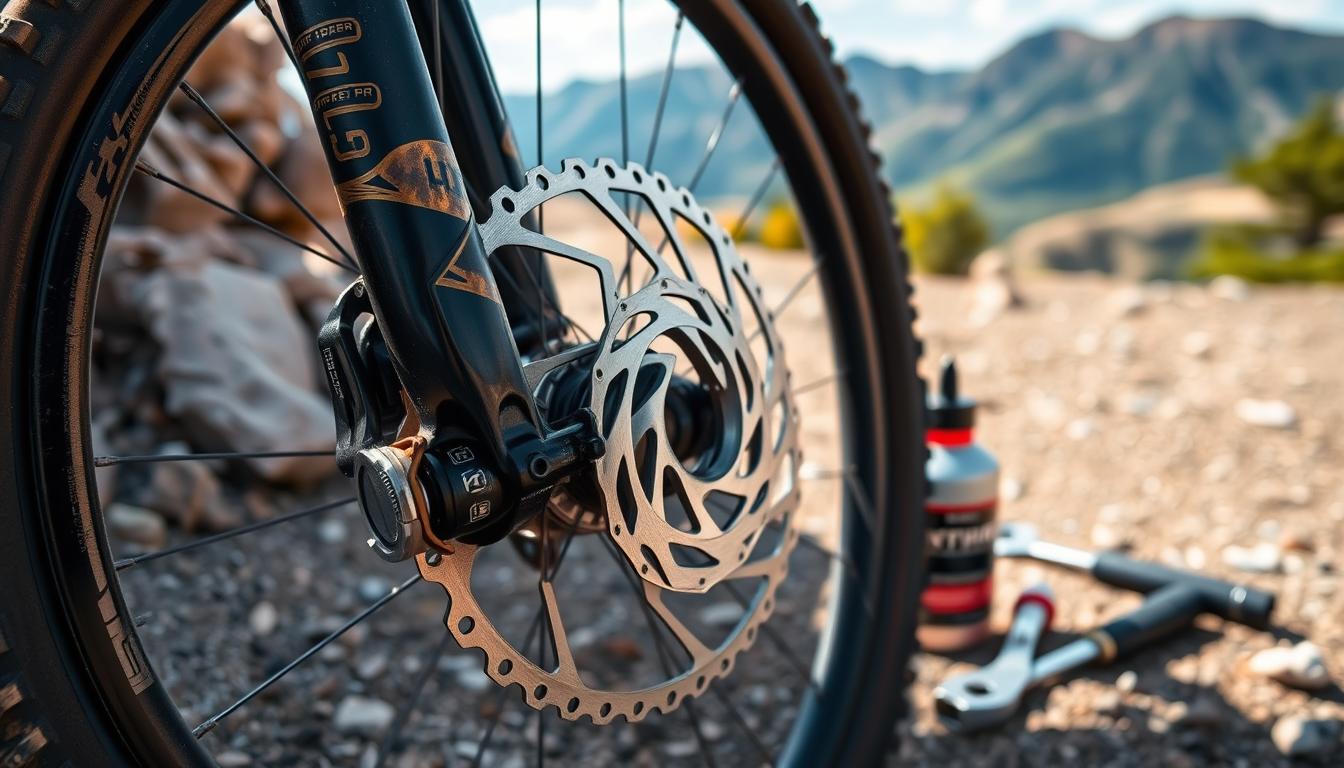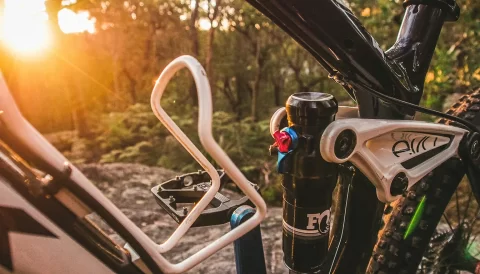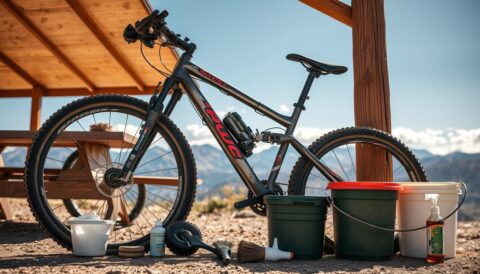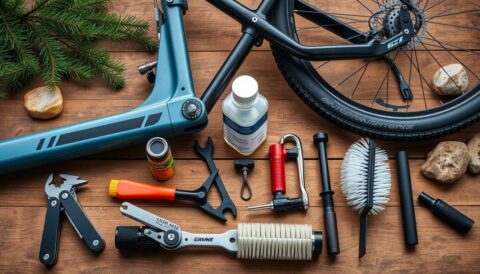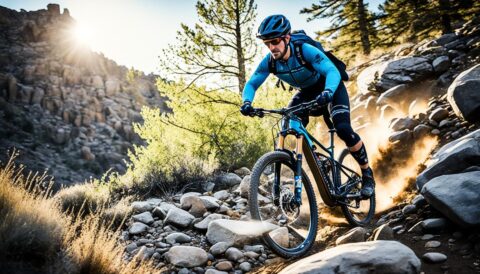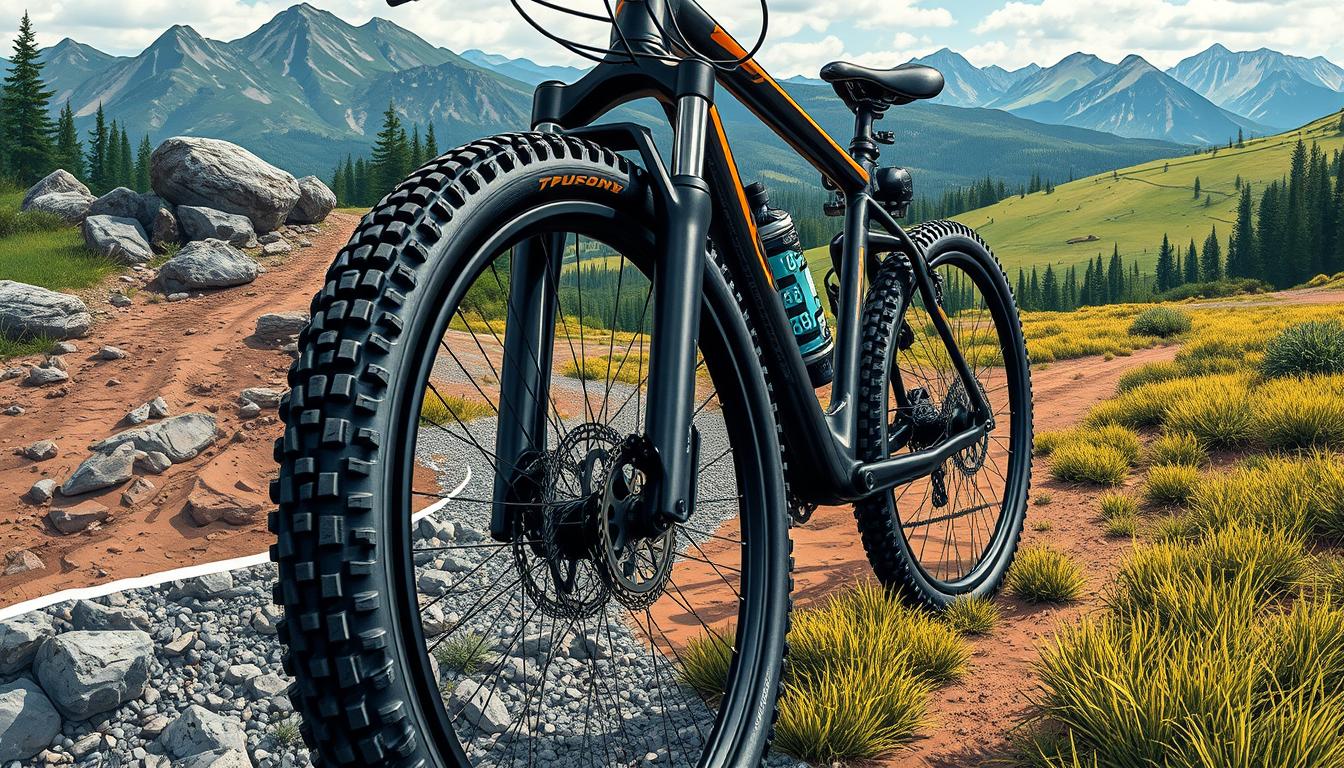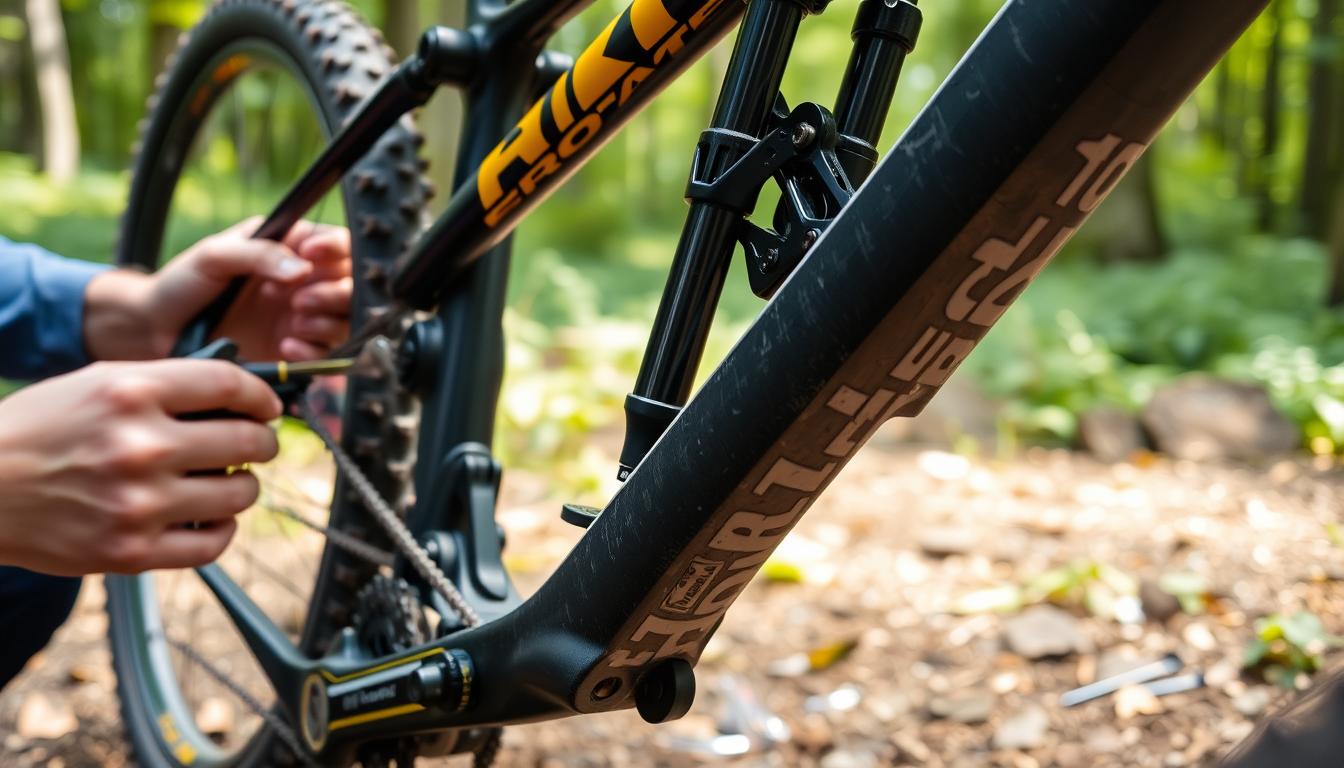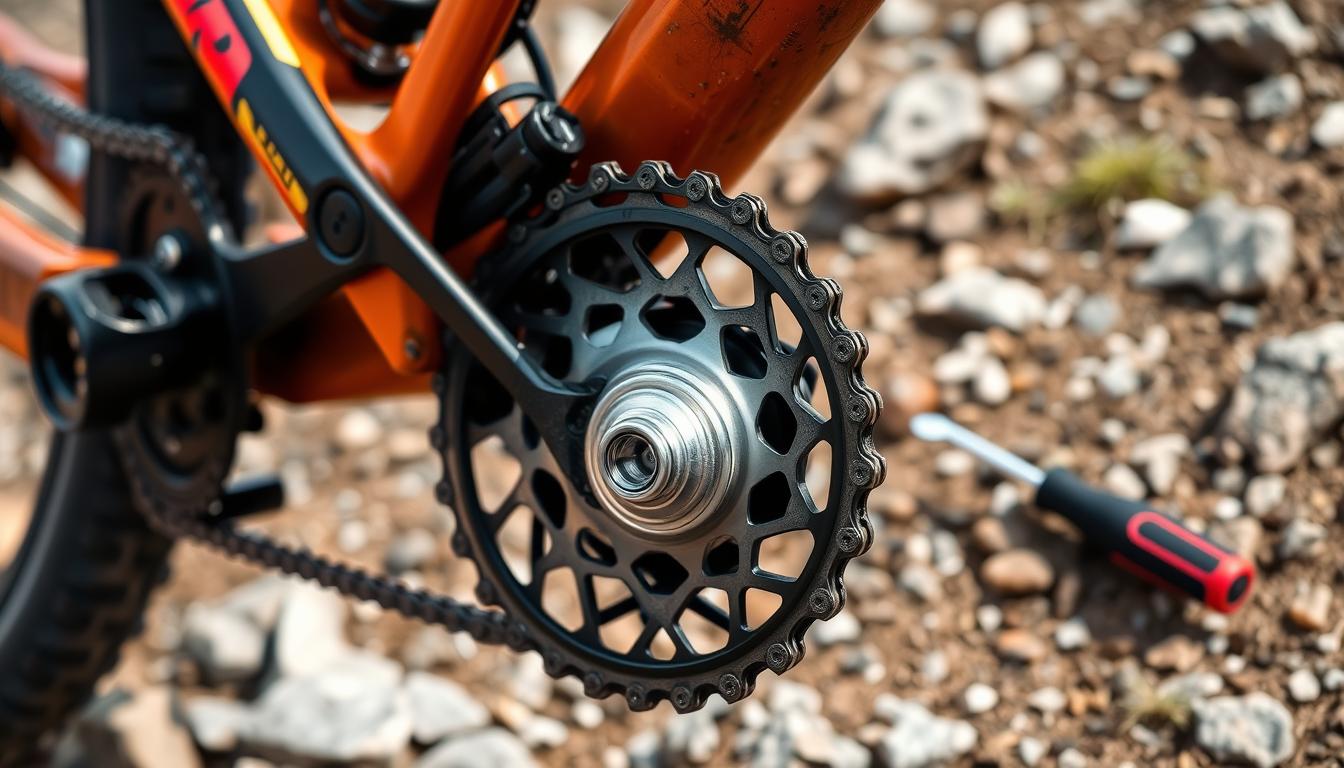Mountain biking requires precise safety measures, with brake maintenance being crucial. Proper brake care ensures rider protection and optimal bike performance. It’s vital for every mountain biker to understand brake maintenance.
Well-kept brakes are the foundation of mountain biking safety. Regular checks prevent unexpected issues and extend your brake system’s lifespan. This knowledge is essential for all riders, from weekend enthusiasts to serious adventurers.
This guide covers everything about mountain bike brake maintenance. We’ll explore basic cleaning methods and advanced troubleshooting. You’ll learn how to keep your brakes in top shape for smooth, reliable performance.
Good brake maintenance improves safety and enhances your bike’s performance and durability. Our expert advice will help you spot potential problems and perform routine care. You’ll keep your mountain bike’s braking system working at its best.
This guide covers disc brakes, hydraulic systems, and mechanical setups. You’ll gain the knowledge to maintain your bike’s most important safety feature. Become an expert in MTB brake maintenance and ride confidently.
Understanding Brake Systems and Their Components
Mountain bike brake systems are vital for rider safety and control. Modern bicycles use various brake technologies. Each type has unique characteristics and performance capabilities.
Hydraulic vs. Mechanical Disc Brakes
Mountain bikes mainly use two disc brake technologies: hydraulic and mechanical. These systems differ greatly in their impact on rider experience.
- Hydraulic disc brakes offer superior stopping power and smooth modulation
- Mechanical disc brakes provide simpler maintenance and lower cost
- Hydraulic systems use fluid pressure for brake activation
- Mechanical brakes rely on cable tension for braking
Essential Brake Parts and Their Functions
Knowing brake components helps cyclists maintain top performance. The main brake components include:
- Brake levers: Control braking force
- Cables/hoses: Transmit braking pressure
- Calipers: Squeeze brake pads against rotors
- Rotors: Spinning metal discs attached to wheel hubs
- Brake pads: Friction material that creates stopping power
*Proper maintenance of brake components ensures reliable and safe mountain bike performance.*
Common Brake Types for Mountain Bikes
Mountain bikes typically use disc brakes for their excellent performance in tough terrain. Steel rotors from 140mm to 203mm provide steady braking in various conditions.
Hydraulic disc brakes with one or more pistons offer powerful and precise stopping. Cyclists should choose brake systems based on riding style, terrain, and personal preference.
Pro mountain bikers often favour hydraulic disc brakes. These brakes provide responsive and controlled braking characteristics.
Tools and Materials Required for Brake Maintenance
Proper mountain bike brake maintenance needs specific tools and cleaning supplies. A well-stocked MTB toolkit ensures smooth rides and prevents mechanical issues.
- Allen key set with multiple sizes
- Torque wrench for precise bolt tightening
- Precision screwdrivers
- Needle-nose pliers
- Brake pad alignment tool
Cleaning is vital for effective brake upkeep. Your cleaning supplies should include:
- High-quality isopropyl alcohol
- Lint-free cleaning cloths
- Soft-bristled brush
- Latex gloves for hand protection
- Dedicated brake cleaner solution
“Proper tools transform bike maintenance from a challenging task to a straightforward process.”
For advanced brake system care, consider specialised equipment like rotor truing tools. These are useful for hydraulic disc brake systems, which need more technical work.
Check your MTB toolkit often and replace worn-out tools. Investing in quality tools ensures long-term bike performance and can prevent costly repairs down the line.
Pre-Maintenance Safety Checks and Inspections
Regular brake checks are vital for your mountain bike’s safety and performance. They prevent accidents and keep your bike in top shape. Proper safety checks can greatly enhance your riding experience.
Visual Inspection Points
Always check your brake system before riding. Look at these key areas:
- Brake pad thickness and wear
- Rotor condition and alignment
- Brake cable tension and integrity
- Mounting bolts and connections
Common Brake System Issues
Mountain bikes often face significant wear, especially in tough conditions. Wet, muddy, or gritty environments can accelerate brake pad deterioration.
Watch out for these potential problems:
- Squealing or grinding noises
- Reduced braking power
- Inconsistent lever feel
- Visible damage to brake components
When to Replace Brake Components
“Prevention is better than cure” – especially when it comes to mountain bike maintenance.
Replace brake parts when:
• Brake pads are below 1.5mm thick
• Rotors show scoring or warping
• Cables are frayed or damaged
• Braking performance drops
Bike experts suggest regular safety checks to keep your mountain bike in top form. Home maintenance is great, but professional checks can spot subtle issues you might miss.
Mountain Bike Brake Maintenance Guide
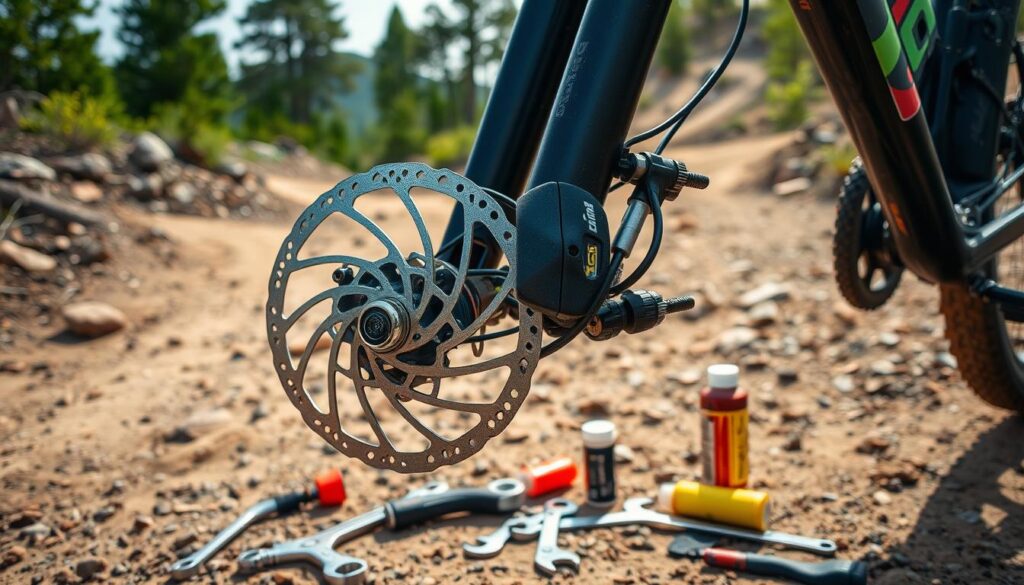
Keeping your mountain bike’s brakes in top shape is vital for safety. Regular upkeep ensures smooth, secure rides. It involves several key tasks that boost performance.
Every mountain biker should know how to adjust their brakes. Start by learning about your specific brake system. Understand its unique needs for the best results.
- Check lever reach and adjust the small screw on the lever body
- Ensure comfortable hand positioning while maintaining control
- Test lever movement before riding
Proper caliper alignment is crucial for efficient braking. Misaligned calipers can cause uneven pad wear. They can also reduce your braking power.
To align your calipers:
- Loosen the caliper mounting bolts
- Squeeze the brake lever firmly
- Retighten bolts while maintaining lever pressure
- Verify even pad contact with the rotor
“Precision in brake maintenance prevents potential riding hazards”
Brake bleeding is crucial for hydraulic systems. It removes air bubbles that can affect brake feel. Use isopropyl alcohol to clean brake parts for a residue-free finish.
Regular care extends your braking system’s life. It also ensures your safety on tough trails. Keep your brakes in check for worry-free rides.
Cleaning and Maintaining Brake Rotors
Mountain bike brake rotors need careful attention for top performance and safety. Disc brakes offer excellent stopping power on various terrains. Proper rotor maintenance can greatly extend your bike’s braking system life.
Proper Cleaning Techniques
Rotor cleaning is vital for maintaining brake performance. Here are some recommended steps:
- Clean rotors with isopropyl alcohol
- Use lint-free cloths to prevent residue
- Avoid touching rotor surfaces with bare hands
- Prevent brake contamination from lubricants
Rotor Inspection and Replacement
Regular rotor checks help prevent brake failures. Look out for these important signs:
- Inspect rotors for warping or cracks
- Measure rotor thickness regularly
- Replace rotors when wear exceeds 0.3mm
- Watch for uneven surface wear
“Prevention is always better than expensive repairs” – Bike Maintenance Experts
Avoiding Contamination
Brake contamination can greatly reduce braking effectiveness. Protect your rotors by:
- Keeping lubricants away from brake components
- Using brake-specific cleaning products
- Preventing chain lube overspray
- Cleaning rotors after bike washing
Using these rotor maintenance tips ensures reliable and safe braking in various riding conditions. Regular care keeps your brakes working well and your rides enjoyable.
Brake Pad Care and Replacement
Keeping your mountain bike’s brake pads in top shape is vital for safety. Regular checks and care ensure reliable stopping power on tough trails. Brake pad wear happens naturally, so stay on top of it.
Knowing when to replace pads can make your brakes last longer. Check your brake pads often for signs of wear. Look out for these key indicators:
- Friction material less than 1 mm thick
- Uneven or crystallised pad surfaces
- Visible contamination from oil or debris
- Reduced braking efficiency
After fitting new brake pads, bedding them in is crucial. This involves doing controlled stops to transfer pad material onto the rotor. It boosts braking power and cuts down on noise.
“Proper brake pad maintenance isn’t just about safety—it’s about maintaining your bike’s peak performance on every ride.”
Follow these key steps when replacing your pads:
- Clean the brake caliper and rotor thoroughly
- Remove old, worn brake pads carefully
- Check caliper alignment and condition
- Install new pads, ensuring proper positioning
- Perform gentle bedding in brakes procedure
Keep an eye on your brake pads and replace them when needed. This will keep your mountain bike safe and performing well on every trail.
Troubleshooting Common Brake Problems
Mountain bike riders face various brake issues that affect their ride. Knowing how to fix these problems keeps brakes working well and riders safe.
Squealing and Noise Issues
Brake noise can be annoying and may signal deeper problems. Dirty rotors, glazed pads, and misaligned callipers often cause brake noise.
Worn brake parts can also make unwanted sounds. To fix this, clean rotors and pads often. Check caliper alignment and replace old parts.
- Contaminated brake rotors or pads
- Glazed brake pad surfaces
- Misaligned brake callipers
- Worn brake components
Poor Braking Performance
Weak brakes can put riders at risk. Worn pads and dirty systems often cause poor braking. Air in brake lines and damaged cables can also be culprits.
- Worn brake pads
- Contaminated brake system
- Air bubbles in hydraulic brake lines
- Damaged brake cables
“Proper maintenance is key to ensuring consistent and reliable brake performance on mountain bikes.”
Brake Fluid Leaks
Brake fluid leaks are serious and need quick attention. Look for fluid drops near the brake system. A soft brake lever or weak braking could indicate a leak.
Damaged seals might also cause leaks. For complex repairs, it’s best to see a professional bike mechanic.
- Visible fluid droplets near brake system
- Soft or spongy brake lever feel
- Reduced braking effectiveness
- Damaged brake system seals
Conclusion
Mountain bike brake maintenance is vital for rider safety and performance. Regular care prevents unexpected failures on challenging trails. Understanding essential techniques can greatly improve MTB safety.
Routine inspections of brake pads are crucial. Check for wear and damage, and clean components regularly. Replace brake pads when surfaces become uneven or worn down.
Mechanical and hydraulic disc brakes need different adjustment approaches. Both types require consistent care to function properly.
Learn to adjust brake tension and inspect cables. Understand the nuances of your brake system. This knowledge can help prevent potential accidents on the trail.
Develop a thorough maintenance routine for your mountain bike. This will keep you safe and confident on every ride. Regular care ensures optimal performance, regardless of your riding style.
For more detailed information, check out this essential maintenance guide for mountain bikes.
FAQ
How often should I perform maintenance on my mountain bike brakes?
Regular brake maintenance is vital. Check brakes before each ride and clean rotors monthly. Do a thorough brake check every 3-6 months or after intense rides. Get professional servicing yearly or when brake performance changes significantly.
What are the key differences between hydraulic and mechanical disc brakes?
Hydraulic brakes use fluid for superior stopping power and smoother performance. They require complex maintenance. Mechanical brakes use cable tension and are simpler and cheaper. However, they typically offer less precise braking power.
How can I tell when my brake pads need replacement?
Check brake pad thickness regularly. Replace pads when they’re less than 1.5mm thick. Look for wear indicators and listen for squealing sounds. Reduced braking performance and visible metal backing indicate it’s time for new pads.
What tools do I need for basic mountain bike brake maintenance?
Essential tools include Allen keys, torque wrench, screwdrivers, and pliers. Cleaning supplies like isopropyl alcohol and soft brushes are crucial. For hydraulic systems, consider a brake bleed kit. Use brake-specific cleaning products to prevent contamination.
Why do my bike brakes squeal, and how can I stop it?
Squealing can result from contaminated rotors, glazed pads, or misaligned calipers. Clean rotors and pads with isopropyl alcohol. Check caliper alignment and ensure proper pad bedding. Inspect for worn components if noise persists.
How do I properly clean my mountain bike rotors?
Use isopropyl alcohol and a clean, lint-free cloth. Avoid touching the rotor surface with bare hands. Gently wipe the entire rotor, ensuring no residue remains. Check for warping or damage during cleaning.
What are signs of brake system problems I should watch for?
Watch for reduced stopping power, spongy brake lever feel, and unusual noises. Look out for fluid leaks, visible wear on pads and rotors. Inconsistent brake performance and excessive lever travel are critical indicators of needed maintenance.
Can I perform brake maintenance myself, or should I visit a professional?
Many tasks can be done at home with proper tools and knowledge. Basic maintenance like cleaning and pad replacement are suitable for DIY. However, complex tasks like hydraulic brake bleeding are best handled by professional mechanics.
How do I properly bed in new brake pads?
Perform controlled stops from moderate speeds. Start with gentle brake applications to transfer pad material onto the rotor. Gradually increase braking intensity, allowing cooling between stops. This improves brake performance and reduces noise.
What environmental factors affect brake performance?
Mud, dust, water, and extreme temperatures can impact brake performance. Clean your brakes after riding in challenging conditions. In wet or muddy environments, more frequent maintenance is crucial to ensure reliable braking.
